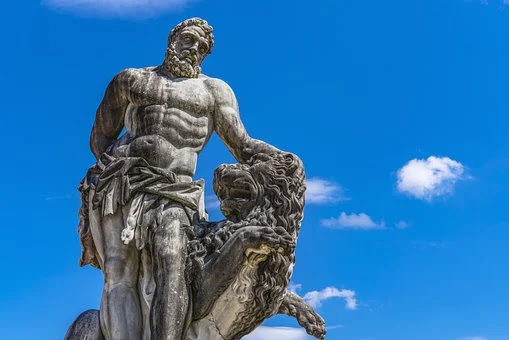Hercules and caco
As already mentioned above, after one of the twelve tests in which Eurystheus ordered him to drive Geryon's cows from Eritia, an island near Iberia and the columns of Hercules, to Argos in Greece, back he passed through Lazio with the oxen, and when he found good grass there for the cattle, he released them to graze and he, tired from the journey, lay down, giving himself up to sleep. Nearby lived a thief from that region called Caco who happened to come across the cows that were grazing with no one to watch over them and felt the desire to appropriate them. But when he saw Hercules dozing, he thought that the matter was difficult to achieve so he hid some cows in a nearby cave, dragging them by the tail so that the tracks left by the animals indicated that they were moving away from the cave, and so on. get that when Hercules woke up, he would follow the wrong track, away from the place and thus be able to dispose of them later, when the danger had passed.
When Hercules woke up and gathered the flock, he realized that some were missing and set about looking for them. Not finding them, despite the fact that the tracks went in the opposite direction, he decided to examine the place. Going towards the cave, he found Caco at the entrance to whom he asked if he had seen the cattle, he claimed not to have seen them and as Hercules requested to go to the cave to make sure and Caco refused, suspecting he led the rest of the herd to Cave. The smell of these reached the captive cattle and their lowing became the proof of the theft. Caco, once discovered, began to fight and ask the locals for help but Hercules killed him with the mace and after removing the captive cows, destroyed the cave to prevent other evildoers from using it. He washed in the river to purify himself from the death committed and erected near the place an altar to Jupiter Inventor (Jupiter Discoverer) and sacrificed an ox as thanksgiving for the finding of the cattle.
The altar built by Hercules was located in the future Rome, next to the Trigémina gate and the Romans maintained the rite for many generations. Every year after the consular election, the new consuls sacrificed a white ox to Capitoline Jupiter through a series of rites similar to those instituted by Hercules. And in the area where he slaughtered the cattle, Ara Maxima, the Forum Boarium or ox market was built, a square located between the Capitol, the Palatine and the Tiber River.
Because of this legend, today thieves are also called thieves.
ManHistories



Comments
Post a Comment